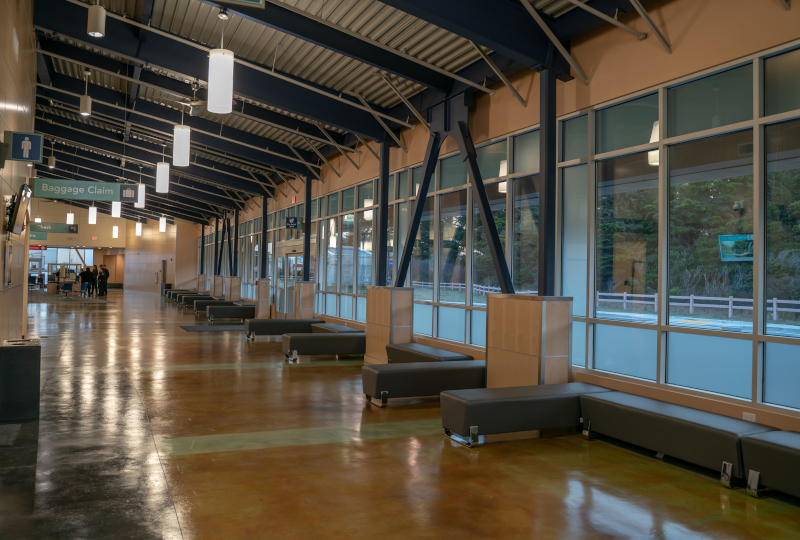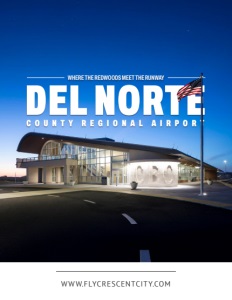Del Norte County Regional Airport (Jack McNamara Field)
Where the Redwoods Meet the Runway
Blending modern infrastructure with regional heritage to support tourism, emergency services, and economic growth in one of California’s most isolated and breathtaking coastal regions.
The Del Norte County Regional Airport, officially named Jack McNamara Field, serves as a critical hub for Del Norte County and the surrounding areas along the remote Northern California and Southern Oregon coast. Originally built as a World War II military airfield, the airport’s strategic location provided valuable crosswind training for military pilots. Today, it functions as a lifeline for local residents, connecting them to larger urban centers.
Ryan Cooley, the airport director, explains, “After World War II, the airport was handed over to civilian control through the Surplus Property Act. The local community and government quickly saw the value in keeping it open as a public facility to support both commercial and general aviation.”
Currently, the airport is served by Advanced Air, a Southern California-based airline that operates essential air service flights. “We have daily flights to Oakland and twice-weekly service to Hawthorne in the LA basin,” Cooley shares. “Since they started five months ago, demand has been robust. Advanced Air has really filled a gap for our community, providing the dependable connections we need.” This service means that residents can access major California cities.
In recent years, the airport has seen significant upgrades. One of the most visible changes has been the construction of a new terminal, completed five years ago. “The previous terminal was outdated, and frankly, it wasn’t equipped to handle potential growth or meet today’s passenger expectations,” Cooley explains. “The new building was designed with functionality and aesthetics in mind. It’s shaped like the wing of an aircraft, and it’s absolutely beautiful.”

Modernizing Critical Infrastructure for a Remote Community
As a transportation hub serving one of California’s most isolated regions, The Del Norte County Regional Airport operates with a unique set of priorities. Its role goes beyond convenience, reaching into areas like emergency medical transport and regional economic development. The airport’s current airport layout plan places heavy emphasis on maintaining and upgrading essential infrastructure.
Cooley shares that the airport’s latest project is a comprehensive rehabilitation of Runway 18/36, backed by a substantial grant from the Federal Aviation Administration. “We received over $7 million from the Department of Transportation’s FAA grant program to restore the runway and upgrade our LED lighting,” he says. These upgrades are integral to supporting commercial and emergency services in a remote area where air transport can be the difference between life and death.
This runway project is part of a broader initiative to enhance safety and operational efficiency at the airport. Cooley emphasizes that these improvements are crucial for passenger flights and services like Cal-Ore Life Flight, the air ambulance provider based out of Jack McNamara Field. “Our air ambulance service is essential to the region,” he notes.
Economic Impact on Del Norte County
The Del Norte County Regional Airport, through its connectivity and resources, plays an essential role in the economic fabric of the community, supporting a wide range of industries and businesses that define the local economy. As Cooley points out, “The airport is a cornerstone of our regional economy, facilitating business travel, tourism, and cargo transport.” For Del Norte County, tourism brings essential revenue, and a modern, accessible airport makes it possible for visitors to reach attractions like the nearby Redwood National and State Parks.
Cooley further notes that tourism is one of the county’s economic anchors. “With the redwoods, national and state parks, and our beautiful coastline, we see a steady flow of visitors. Local hotels, motels, and vacation rentals rely heavily on this influx,” he says. Restaurants, breweries, and cafes—like SeaQuake Brewing and the Chart Room—cater to these tourists, particularly during peak season, and remain open year-round. The airport’s commercial flights make it easier for travelers to visit this remote part of California, helping sustain the hospitality industry.
Beyond tourism, Del Norte’s economy is bolstered by commercial fishing and agriculture, sectors that depend on both local and broader market connections. “We have a robust fishing industry, especially for Dungeness crab and salmon,” Cooley explains. “Crescent Seafood, located right at the harbor, processes fresh seafood and sells it locally.” Agriculture is another pillar, with Del Norte County known for its dairy products. Romano Cheese Company, one of California’s oldest family-owned cheese producers, is a local gem, benefiting from the airport’s ability to facilitate faster transport of goods.
Healthcare is another crucial area supported by the airport. “We have Sutter Coast Hospital—the only hospital in the region,” Cooley says. “It’s essential that we can get their practitioners, doctors, and administrative staff in and out efficiently to ensure consistent, quality care.” With limited ground transport options, air travel allows healthcare professionals to attend necessary training, conferences, and meetings. Education and public services also rely on the airport for smooth operations. Del Norte County has a single high school and several elementary schools, along with the College of the Redwoods’ local campus.

Solving Development Challenges while Building Community Partnerships
The Airport’s location thoughtfully influences its operational priorities, while also guiding its approach to sustainable growth. Surrounded by protected wetlands, coastal lands and tribal lands, any expansion requires careful planning and coordination. “We’re under the jurisdiction of the California Coastal Commission, and a lot of our land here is classified as wetlands,” Cooley explains. “There’s a significant amount of legwork involved in environmental mitigation, land swaps, and other measures just to make development possible.”
“The combination of coastal lands, wetlands, and neighboring tribal territories creates a unique challenge,” Cooley adds. “We have to be sensitive in how we approach any expansion—making sure it’s sustainable and respectful of our surroundings.”
This intricate web of regulatory and environmental factors guides every decision about land use, balancing the airport’s commercial and industrial development potential with the preservation of the natural beauty that defines the area.
Collaborative partnerships further extend the airport’s impact, linking it closely with both public and private entities that support its mission. Cal-Ore Life Flight, a fixed-base operator (FBO) and air ambulance provider, is one of the airport’s key allies. “They’re a fantastic partner,” Cooley remarks. “Not only do they provide crucial FBO services, like fueling for general aviation and commercial flights, but they’ve also been instrumental in helping us seek funding for airport improvement grants.”
Local organizations, including the Del Norte County Chamber of Commerce and Visit Del Norte County, also contribute to the airport’s success by promoting tourism. Meanwhile, the partnership with Sutter Coast Hospital is vital for patient transport, particularly in emergencies where speed is paramount. “Cal-Ore Life Flight works alongside local medical facilities like Sutter Coast Hospital to transport critical care patients,” Cooley says. “The hospital also advertises with the airport to raise awareness about their services in the community.”
Operating under a Joint Powers Authority (JPA) structure, The Border Coast Regional Airport Authority draws support and oversight from a coalition of regional entities, including Del Norte County, Crescent City, Curry County in Oregon, and two local tribal governments, Tolowa Dee-ni’ Nation and Elk Valley Rancheria. “The JPA brings together stakeholders from both the California and Oregon coasts,” Cooley notes. “It takes all these different entities working together to make the airport successful.” This collaborative governance model reflects the shared interests of multiple communities and ensures that the airport serves as a true regional asset.
For Cooley, this spirit of cooperation goes both ways. “When communities come together to enhance their airports, those airports, in turn, help build stronger communities,” he says, reflecting on wise words once said. Through a mix of careful development, educational outreach, and strategic partnerships, The Del Norte County Regional Airport has become a cornerstone for the region, weaving together economic opportunity, emergency services, and community pride.
Priorities for the Future: Safety, Modernization, and Service
Looking ahead, Airport priorities cover ongoing modernization and safety improvements that align with the needs of its community. Cooley emphasizes that the airport’s mission is not just about maintaining the status quo, but about enhancing the facility to meet future demands and ensure its long-term value for the region. “Our focus is on advancing Jack McNamara Field’s infrastructure to make it state-of-the-art,” he says. “We’re dedicated to providing top-of-the-line safety, security, and service for both local and regional travelers.”
These goals build on the foundations of the past, from runway upgrades to terminal improvements, each reinforcing the airport’s reliability and accessibility. Cooley’s team will continue this trajectory by updating critical facilities to support the smooth operation of flights, ground services, and essential community functions like medical transport. “We’ve put a lot of work into the infrastructure already, but there’s more to do,” he remarks. With an eye on the future, the airport aims to position itself as a resilient, well-equipped hub that serves both practical needs and the broader ambitions of the region.
AT A GLANCE
Del Norte County Regional Airport (Jack McNamara Field)
What: Regional airport supporting commercial flights, general aviation, and emergency services
Where: Crescent City, California
Website: https://www.flycrescentcity.com/
PREFERRED VENDORS
Elk Valley Rancheria – www.elk-valley.com
The Elk Valley Rancheria Tribe in Crescent City, California, honors a rich cultural heritage and community spirit. Their enterprises, including Elk Valley Casino and Tribal Fuel Mart, support economic growth and sustain tribal traditions amidst breathtaking natural surroundings. They are committed to cultural preservation and community development.




